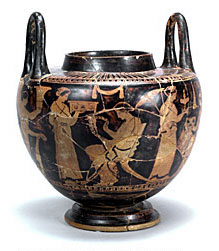Diniacopoulos collection at MMFA

Attic red-figure lebes (wedding ritual vase) in the manner of the Naples Painter 430 B.C.E. Pottery. Collection Diniacopoulos du Musée national des beaux-arts du Québec
Early in February, our downtown neighbour, the Montreal Museum of Fine Arts will open two new Mediterranean Archaeology Galleries with a strong Concordia connection.
It will include pieces from the extensive collection of the late Olga and Vincent Diniacopoulos, whose son, Denis, was a professor in Concordia’s Communication Studies Department. He died in 1997.
After the death of Professor Diniacopoulos’, his mother oversaw the creation of a large and varied bequest to the university. This included a collection of BBC World Service news tapes collected by her son; the tapes were made into a CD-ROM archive by the Concordia Centre for Broadcasting Studies. The bequest also provided an endowment for undergraduate scholarships.
A portion of the art collection had been sold to the Quebec government in the 1960s, when Vincent Diniacopoulos died. It is owned by the Musée national des beaux-arts du Québec, which has loaned the material to the MMFA for the new gallery on a long-term basis.
Clarence Epstein, PhD, an art scholar who handles special projects in the Rector’s Cabinet, has been working closely with the MMFA. He calls the Diniacopoulos collection “the best and most representative assemblage of Greek and Roman antiquities in Eastern Canada.”
“Nearly half the collection consists of Greek pottery, ranging from three Late Bronze Age stirrup jars to Athenian vases of the fourth century BCE. The groups of black-figured and red-figured Athenian vases contain works of several individual painters, including the newly identified ‘Diniacopoulos painter.’
“The second focus of the collection is the sculpture. Notable are two fourth-century BCE Athenian pieces: a beautiful funerary stele and a fragment of a marble funerary lekythos, both showing farewell scenes. They are accompanied by several portrait heads of Helenistic and Roman date.
“A third area of concentration in the Diniacopoulos collection is the 15 pieces of ancient glass, mostly of Roman imperial date. There are also small groups of terracotta and metal objects.
Concordia classics professor Jane Francis and the MMFA’sJohn M. Fossey are organizing a colloquium about the family and the collection for Feb. 4 and 5. They are publishing a catalogue of all 74 pieces, including some detailed studies.
The opening of the Mediterranean gallery coincides with a show coming from the Louvre at the MMFA called Tanagra: A Small World in Clay. It runs from Feb. 5 to May 9, and it promises to be worth seeing.
If you work or study on the downtown campus, you’re only a block from the Montreal Museum of Fine Arts, and entrance to the Mediterranean Galleries is free.
Adventurous collectors
From their formative years in Constantinople and Cairo and early expeditions through Europe, the Middle East and Asia Minor to their decisive move from France to Canada soon after World War II, Vincent and Olga Diniacopoulos led fascinating lives.
Vincent Diniacopoulos (1886-1967) was born in Constantinople of Greek parents during the reign of Ottoman Sultan Abdul Hamid. Educated in local seminaries, by age 14 he was roaming the Turkish countryside in search of ancient relics.
His wife, Hélène Olga Nicolas (1906-2000), was born in Cairo. Her Greek father was an engineer on the construction of the Suez Canal. At the age of 17 she moved to Paris and studied archaeology at the École du Louvre and the Sorbonne.
In the years prior to World War II, the husband-and-wife team were active in the antiquities trade, enlisted by such institutions as the British Museum, the Louvre and the Metropolitan Museum of Art to gather works in Egypt and Asia Minor.
In 1951, having decided that Europe was no longer a place to live, they set off on the Empress of Canada for Montreal, taking with them more than 40 crates of artwork from their personal collection.
On this transatlantic voyage they met two French-Canadian priests returning from Europe. Within five years, these men helped to broker the creation of a temporary exhibition of antiquities at the Séminaire de Valleyfield. The Diniacopoulos collection was deemed one of the the largest and most important private collections of antiquities in Canada.
In the 1960s, following the death of Vincent Diniacopoulos, the family sold a portion of their collection to the government of Quebec; it has been on occasional display at several venues.
From an article in Collage, the MMFA magazine, by Clarence Epstein and John M. Fossey